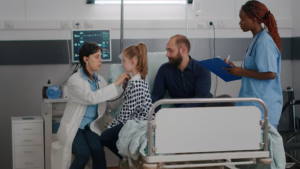The Future of Polysomnography Tech in Allied Health: Expanding Roles & Opportunities
Sleep is the cornerstone of human health, but millions of people have great difficulty getting it. Enter polysomnography technology (Polysomnography Tech), the unsung hero of modern sleep medicine.
Polysomnography techs, the specialists manning the monitors and analyzing the data, are at the front lines of diagnosing sleep disorders such as sleep apnea, insomnia, and narcolepsy.
This important field is constantly evolving, just as health care evolves. With technological advances, changes in patient needs, and increasing focus on holistic care, the future of polysomnography is Promethean, nigh onto the paradigm-shifting.
The Growing Demand for Sleep Science
Sleep disorders are so much more than an annoyance. They’re associated with chronic conditions such as heart disease, diabetes, and depression. An estimated 50–70 million U.S. adults are affected by a sleep disorder, but even fewer receive appropriate diagnosis and treatment. This gap emphasizes the clear demand for trained polysomnography technologists (PSGTs).
The COVID-19 pandemic has put sleep in overdrive: Stress, new routines and more time spent in front of a screen have students (and many, many more) throwing off their natural sleep schedules. A study published in 2022 reported that 40 percent of adults said their sleep quality had declined during the pandemic.
Employment of diagnostic medical sonographers and cardiovascular technologists and technicians is projected to grow 11% from 2023 to 2033, much faster than the average growth rate for all occupations, according to the U.S. Bureau of Labor Statistics (BLS).
This growth is driven by an aging population and the growing demand for diagnostic imaging services.
In contrast, the BLS projects total employment to increase by 4% over the same time frame, suggesting that the projected need for diagnostic technologists outstrips overall job growth.
This data only further emphasizes the growing opportunities in the field of diagnostic technology and the vital role it plays in modern medicine.
But what does it all mean for the field? Let’s dive in.
Today’s Polysomnography: A Blend of Art and Science
Polysomnography (PSG) is a test that records brain waves, oxygen levels, heart rate, and breathing during sleep. Traditionally, this meant an overnight stay in a lab, wired to machines. In-lab studies are the gold standard, of course, but the process can feel intrusive. Patients describe it as “like trying to sleep in a hotel room with science equipment strapped to your body.”
Yet, the modified data is priceless. Consider, for example, Sarah, a 45-year-old teacher who battled daytime fatigue for years. A PSG study showed severe obstructive sleep apnea (OSA), a disorder where a person’s breathing repeatedly stops during sleep.
With treatment, her energy returned. “It changed my life,” she says. Sarah’s story is a useful one: it illustrates the importance of PSGTs because they convert raw data into actionable insights.
Innovations Reshaping the Field
The merging of cutting-edge technology with patient-focused care points the way forward for polysomnography. Here’s what’s on the horizon:
1. Wearable Technology and Home Sleep Tests
What would it be like to be able to diagnose sleep apnea in your own bed? In-lab studies have been supplanted by home sleep apnea tests (HSATs) for certain uncomplicated cases. Such devices as WatchPAT or Alice NightOne are easy to use, portable, and low cost.
A report in 2023 from Grand View Research pegged the global sleep apnea devices market at USD 4.5 billion in 2023 and expected it to grow at a compound annual growth rate (CAGR) of 6.2% from 2023 to 2030.
Wearables such as Fitbit and the Apple Watch are also getting into the act. Although they can’t yet replace full PSG, they track sleep stages, heart rate, and oxygen saturation, allowing users to identify trends. For PSGTs, this translates into more data to analyze — and more chances for early intervention.
2. Artificial Intelligence (AI) and Machine Learning
The future of sleep analysis is being transformed by AI. In minutes, algorithms can already comb through hours’ worth of PSG data, popping up flags for abnormalities like apneas or limb movements. “EnsoSleep reduces manual scoring time by over 30–50% with its AI-powered software, thus enabling techs to focus on complex cases,” she explains.
AI also tailors treatment to individual patients. Researchers at MIT are working on models in which patients’ responses to CPAP therapy, the standard OSA treatment, can be predicted. This may reduce the need for trial-and-error adjustments, resulting in higher patient compliance.
3. Telemedicine and Remote Monitoring
The pandemic sped up the adoption of telehealth, and sleep medicine is no different. Virtual consultations allow PSGTs to guide patients through home studies, review results, and adjust treatments remotely. Nationally, platforms like SleepCharge help connect patients with specialists.
Telemonitoring is growing as well. Implantable devices such as Inspire Therapy, which sends electrical impulses to throat muscles to keep airways open, transmit data directly to the clinicians. “It’s like a sleep lab in your body,” says Dr. Michael Simmons, a sleep specialist in California.
The Human Touch in a Tech-Driven World
Even with all this progress, polysomnography is still deeply human. Techs don’t merely interpret waveforms—they soothe nervous patients, clarify baffling results, and celebrate breakthroughs.
Think about the difficulty of pediatric sleep studies. The lab environment can be difficult for children — particularly for those with autism or sensory issues. A skilled PSGT will apply creativity, making ECG lead placement into a “space astronaut” game or letting children bring stuffed animals.
Such small moves build trust, keeping data that can be trusted. Likewise, older patients may have mobility problems or dementia. At the same time, here, empathy is as important as technical skill.
Challenges Ahead: Training, Diversity, and Access
The field does have hurdles, however. For one, standardized training programs are rare. Though the Board of Registered Polysomnographic Technologists (BRPT) provides certification options, there are diverse educational routes into polysomnography. Community colleges and online courses are picking up some of the slack, but more accredited programs are needed to supply the demand.
Diversity is another issue. A 2021 survey by the American Association of Sleep Technologists (AAST) revealed that 72% of PSGTs identify as white. Increased representation may lead to better care for under-served communities, where sleep disorders tend to be underdiagnosed, the report notes.
Accessibility is also an issue. There are fewer sleep labs in rural areas, and HSATs are not always covered by insurance. Changes to policies, such as the expansion of Medicare coverage for in-home studies in 2022, are a step forward — but advocacy for additional access is ongoing.
The Road Ahead: A Career with Purpose
The future, at least for hopeful PSGTs, looks bright. The position has expanded to cover much more than gathering data — it’s also about teaching patients, conducting research, and developing tech. Some techs specialize in neurodiagnostics or cardiology; others transition into leadership roles.
In addition, interdisciplinary collaboration is increasing. Now, sleep techs work with pulmonologists, neurologists, and mental health specialists to treat the underlying causes of sleep problems.
Want to be at the cutting edge of it? StaffDNA gives you access to the best polysomnography tech jobs with great pay and allows you to create a career that works for you. Find career opportunities today and take the first step towards a career in sleep science!
Check out these other great Staffdna articles

Hospitalist Jobs vs. General Physician Assistant Jobs: What’s the Difference?
When medical professionals are considering their career options, the first things that come to mind are either hospitalists or general physician assistants.

Busting Myths About PRN Nursing Jobs: Pros, Cons & How to Find the Best Shifts
PRN nursing jobs have become a favorite among medical professionals looking for flexibility and higher pay. Yet, many misconceptions exist about PRN positions that scare some nurses away from considering it as a career choice.

How to Handle the Pressure of PACU Nursing Jobs Without Burning Out
Nursing is a demanding field, which becomes even more challenging when it comes to PACU nursing jobs.

How to Transition from Staff Nurse to A Travel Nurse
If you are a Registered Nurse with a strong desire to travel to different locations and save lives, you can be a travel nurse.

Travel Nursing: How to Choose the Best Career Assignments
Travel nursing is one way for nurses to work through new locations while also building their skill sets.

Understanding the PICU: A Guide for PICU Nurses
The pediatric intensive care unit (PICU) is a specialized department in hospitals and medical facilities. It is made to provide intensive care to infants, children, and adolescents with severe medical conditions.
